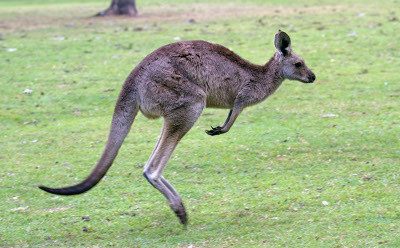Kangaroo
Category: Marsupial

Facts about Kangaroos "Scientific name for Kangaroo is Macropus". The kangaroo belongs to the family Macropodidae.
As the name suggests, kangaroos have large feet and are marsupial. They are endemic to Australia but one genus the tree kangaroo can also be found in Papua New Guinea. Their hind legs are large and powerful while their feet are adapted for leaping. They have a long muscular tail that gives them balance while moving. They have a pouch called marsupium where their joeys complete their development.
Locomotion of Kangaroos
Kangaroos happen to be the only large animals that move around by hopping. They can move comfortably at a speed of between 12.5 to 15.5 miles per hour (20 and 25 kilometers per hour). Within short distances, they can cover up to 44.4 miles per hour (70 kilometers per hour). Their locomotion has been specifically developed to enable them move from one place to another in search of food, water and to escape from predators.
Diet of Kangaroos
Kangaroos chew cud just like cattle and sheep. This is because of its 4 chambered stomach. Different species of kangaroo feed on different diets. For instance, the eastern grey kangaroo is a grazer and therefore eats a variety of grasses. Others eat shrubs while the smaller species consume hypogeal fungi. The red kangaroo is the largest marsupial and largest kangaroo. The average length from the red kangaroo's head to its buttocks is 3 feet 2 inches to 5 feet 2 inches (1 to 1.6 meters) long. Its tail adds another 35 1/2 to 43 1/2 inches (90 to 110 cm) to its length and its entire body weighs around 200 lbs. (90 kg). The musky rat-kangaroo is the smallest kangaroo. It is only 6 to 8 inches (15.24 to 20.32 cm) long and weighs only 12 ounces (340 grams). Its rat looking tail hence its name is 5 to 6 inches (12.7 cm to 15.2 cm) to its length.
Reproduction and Adaptation of Kangaroos
Because of the nature of their habitats, kangaroos have developed adaptation mechanisms that enable them to survive in the dry and infertile countries. They have a gestation period of between 31 and 36 days. After this, they give birth to their young ones who complete their development in the pouch. They stay in the pouch for a period of 9 months before the weaning process starts.
Interestingly, the female kangaroo has the capacity to freeze the development of an embryo until the joey leaves the pouch. This is a process known as diapause and it happens mostly in times of drought and in areas with little or no food sources.
Kangaroos have a life span in excess of 20 years when in captivity. However, when left alone in the wild their lifespan averages 6 years.
"Scientific name for Eastern grey kangaroo Macropus giganteus".

 Back To Category Marsupial
Back To Category Marsupial